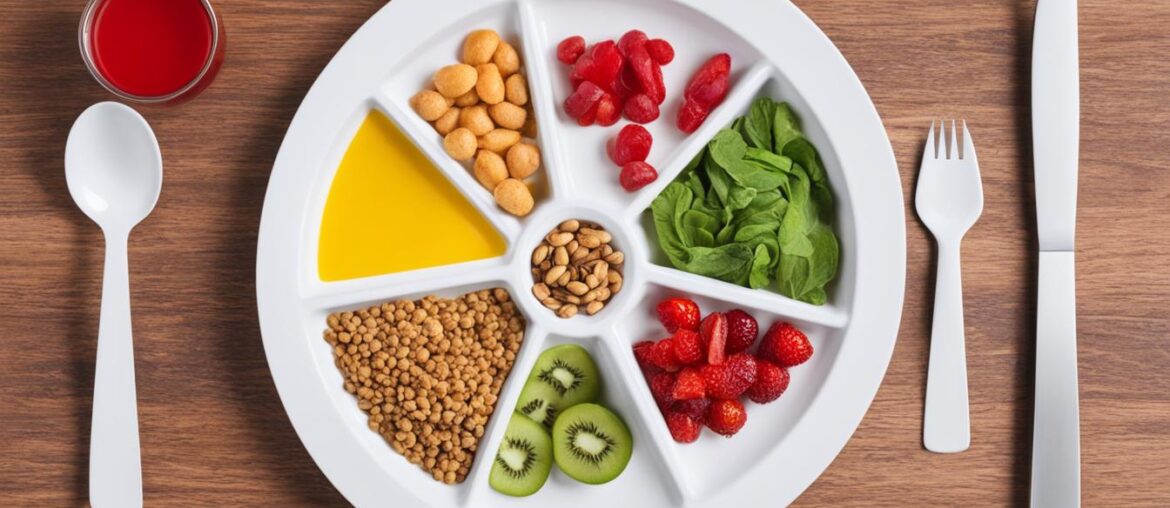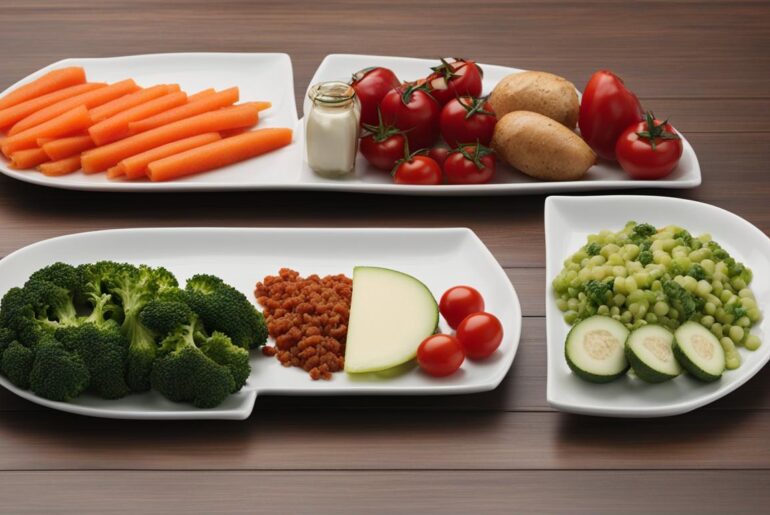Hello, I’m here to talk about the power of portion control when it comes to achieving rapid weight loss. If you’re looking to lose weight quickly and effectively, understanding portion control can make all the difference. By managing the amount of food you eat during meals, you can take control of your weight and embrace a healthier lifestyle.
So, how fast can you lose weight with portion control? It depends on various factors such as your age, current weight, height, metabolism, gender, and physical activity levels. Consulting with a healthcare professional can help determine the appropriate caloric intake for weight loss specific to your needs.
Portion control involves more than just counting calories. It’s about adopting healthy weight loss strategies that promote sustainable habits. Using smaller plates, portion control plates, measuring cups, and visualizing portion sizes can help tremendously (check out my post on portion control plates here). Waiting before going for a second portion, avoiding adding extra carbs, and eating more slowly are additional tips that aid in effective portion control.
Implementing a few simple habits like drinking water before a meal, keeping a food diary or using a tracker app, and avoiding eating straight from the container can also significantly contribute to portion control success. It’s crucial to be aware of suitable serving sizes and track your intake to stay on top of your weight loss journey.
Key Takeaways:
- Portion control is an effective tool for rapid weight loss.
- Understanding portion sizes and their impact on weight management is crucial.
- Consulting with a healthcare professional can help determine the appropriate caloric intake for weight loss.
- Using smaller plates, portion control plates, and measuring cups aid in portion control.
- Waiting before going for a second portion, avoiding extra carbs, and eating slowly contribute to effective portion control.
Understanding Portion Control for Weight Loss
Portion control is an essential practice for individuals aiming to achieve weight loss goals. By managing the amount of food consumed during meals, individuals can develop healthy eating habits that support their weight loss efforts (see my post here). It is vital to understand portion sizes and how they impact food intake to make informed decisions about one’s diet.
Portion control focuses on choosing appropriate amounts of food for each meal, rather than depriving oneself of specific foods. It is crucial to be aware of recommended serving sizes and understand the difference between a portion and a serving. This knowledge helps individuals maintain a moderate weight by consuming the right quantities of food.
Implementing portion control techniques does not mean restricting oneself or eliminating entire food groups (check this post out). It is about finding a balance and selecting the right portions of different food groups to create a well-rounded meal. By incorporating portion control into their daily routine, individuals can enjoy a variety of foods while still working towards their weight loss goals.
The Difference Between a Portion and a Serving
It is important to clarify the difference between a portion and a serving when discussing portion control. A portion refers to the amount of food an individual chooses to eat during a meal or snack. On the other hand, a serving is a standardized measure of food, typically outlined on nutrition labels or recommended dietary guidelines. Understanding this distinction helps individuals monitor their food intake and make healthier choices.
Visualizing Portion Sizes
Visual cues can assist in understanding portion sizes and guide individuals towards appropriate food portions. The plate method is a popular visual guide that divides a dinner plate into sections for different food groups. Half of the plate is dedicated to vegetables, a quarter to protein, and the remaining quarter to carbohydrates. This method helps individuals create well-balanced meals and control their portion sizes.
Benefits of Portion Control for Weight Loss
Portion control not only helps with weight loss but also encourages healthy eating habits by promoting moderation and balance. By managing portion sizes, individuals can stabilize their food intake and avoid overeating, leading to sustainable weight loss results (check this post out).
Understanding portion control is essential for individuals looking to achieve and maintain a healthy weight. By practicing portion control and making conscious decisions about food portions, individuals can develop a healthier relationship with food and achieve sustainable weight loss.
Practical Tips for Portion Control

Implementing practical tips for portion control can greatly contribute to successful weight loss strategies. By incorporating these strategies into your daily routine, you can effectively manage your food intake and achieve your weight loss goals. Here are some key tips:
- Use smaller plates: When serving your meals, opt for smaller plates. Research has shown that using smaller plates can create the illusion of a larger portion, helping to prevent overeating.
- Utilize portion control plates: Consider investing in portion control plates, which are specifically designed to guide individuals in filling their plates with the right proportions of different food groups.
- Take advantage of measuring cups: Measuring cups are a handy tool for accurately gauging specific amounts of food. You don’t need specifically designed portion control measuring cups; any cup, mug, or container that measures a specific amount can be used.
- Keep a food diary: Keep track of your daily food intake by maintaining a food diary or using a tracking app. This can help you become more aware of portion sizes and make informed decisions about your eating habits.
- Drink water before a meal: Prior to sitting down for a meal, drink a glass of water. This can create a feeling of fullness, helping to prevent overeating.
By incorporating these practical tips into your daily routine, you can support your portion control efforts and maximize your weight loss results.
| Practical Tips for Portion Control | Benefits |
|---|---|
| Use smaller plates | Prevents overeating by creating the illusion of a larger portion |
| Utilize portion control plates | Guides individuals in filling their plates with the right proportions of different food groups |
| Take advantage of measuring cups | Helps gauge specific amounts of food |
| Keep a food diary | Increases awareness of portion sizes and overall food intake |
| Drink water before a meal | Promotes a feeling of fullness and prevents overeating |
Expert Tip: The Plate Method
The plate method is a visual guide that can be used to ensure appropriate portion sizes. It divides the plate into sections for different food groups, such as half for vegetables, a quarter for protein, and a quarter for carbohydrates. This method, even without a portion control plate, can help individuals make conscious choices about their food intake and support portion control efforts.
By following these practical tips for portion control, you can establish healthier eating habits and achieve successful weight loss.
Portion Control Strategies for Eating Out
Eating out can present challenges to portion control, especially since restaurant portions tend to be larger than standard serving sizes. However, there are effective strategies that can be employed to manage portion sizes while dining out.
Asking for a half portion or a children’s dish can significantly reduce calorie intake. This allows you to enjoy a delicious meal while keeping your portions in check.
Sharing a meal with someone else is another great way to control portion sizes. By splitting a dish, you can enjoy the dining experience without overindulging in a large portion.
Ordering a starter and side instead of a main dish is a smart choice for portion control. This allows you to enjoy a variety of flavors without consuming an excessive amount of food.
Choosing side salads or vegetables as a main course is a healthy option that promotes portion control. These options are typically lighter and can help you feel satisfied without overeating.
Asking for sauces and dressings on the side is another effective strategy. This allows you to control the amount of these high-calorie additions, preventing them from overpowering your meal.
Avoiding buffet-style restaurants is advisable when practicing portion control. These establishments often offer unlimited servings, making it easy to overeat.
By being mindful of portion sizes and making conscious choices when eating out, you can maintain your weight loss goals while still enjoying meals outside of your home.
Portion Control Strategies for Eating Out
| Strategy | Description |
|---|---|
| Ask for a half portion or a children’s dish | Reduce calorie intake by opting for smaller portions. |
| Share a meal with someone else | Control portion sizes by splitting a dish with a dining partner. |
| Order a starter and side instead of a main dish | Enjoy a variety of flavors without consuming a large portion. |
| Choose side salads or vegetables as a main course | Opt for lighter options that still provide satisfaction. |
| Ask for sauces and dressings on the side | Control the amount of high-calorie additions to your meal. |
| Avoid buffet-style restaurants | Prevent the temptation to overeat with unlimited servings. |
The Importance of Eating Slowly

Eating slowly is an essential aspect of effective portion control and successful weight management (check this post out). By practicing mindful eating and taking the time to savor each bite, individuals can optimize their eating habits and reduce their overall food intake. Several studies have highlighted the benefits of eating slowly, including increased feelings of fullness and decreased food consumption.
When we eat slowly, our brain has the opportunity to register the feeling of fullness, which usually takes about 20 minutes to manifest. By eating at a slower pace, we give our brain time to recognize that we are satisfied, helping to prevent overeating and unnecessary calorie consumption. Taking smaller bites, chewing each mouthful thoroughly, and focusing on the meal without distractions are all effective strategies to help slow down the eating process.
“Eating slowly allows us to tune in to our body’s cues and eat in response to hunger and fullness.”
By adopting mindful eating practices and consciously savoring each bite, we can better control our portion sizes and reduce the risk of overeating.
Benefits of Eating Slowly
Eating slowly has numerous benefits beyond portion control. It allows us to fully enjoy our food, savoring the flavors and textures. This can enhance the overall dining experience and satisfaction with our meals. By taking our time to eat, we can also improve digestion and nutrient absorption as the process of chewing begins the breakdown of food and stimulates the production of digestive enzymes.
Furthermore, eating slowly promotes mindfulness and helps us develop a healthier relationship with food. It allows us to tune in to our body’s cues and eat in response to hunger and fullness, rather than relying on external factors such as time or emotions. By practicing mindful eating and eating slowly, we can foster a deeper connection with our bodies and make more conscious choices about what and how much we eat.
Overall, incorporating the habit of eating slowly into our daily lives can have a significant impact on portion control, weight management, and overall well-being.
Takeaways
- Eating slowly allows the brain to register fullness, reducing the likelihood of overeating.
- Taking smaller bites, chewing thoroughly, and focusing on the meal without distractions can help slow down the eating process.
- Eating slowly enhances the overall dining experience, improves digestion, and promotes mindfulness.
- By incorporating mindful eating practices and eating slowly, individuals can better control portion sizes and reduce overall food intake.
Using Visual Cues for Portion Control
Visual cues play a crucial role in guiding portion control and ensuring suitable serving sizes. By incorporating visual aids, individuals can better manage their food intake and support their weight loss goals.
The plate method is an effective visual guide that divides the plate into sections for different food groups. It recommends filling half of the plate with vegetables, one-quarter with protein, and one-quarter with carbohydrates. This method can be followed even without a portion control plate, as long as the recommended serving sizes are observed.
Another practical approach is using hands as a serving guide. Each part of the hand corresponds to a portion of different food groups. For example, one palm-sized portion represents carbohydrates, one hand-sized portion represents protein, and two palm-sized portions represent vegetables.
By being aware of suitable serving sizes and utilizing visual cues such as the plate method and hand portions, individuals can effectively control their portion sizes and contribute to successful weight loss.
Applying visual cues to portion control can greatly enhance the accuracy and effectiveness of managing food intake. It provides a tangible and easily understandable method for individuals to portion their meals appropriately.
Conclusion
Portion control is a proven and effective strategy for achieving rapid weight loss and maintaining a healthy weight. By understanding portion sizes and implementing practical tips for portion control, individuals can successfully manage their food intake and achieve their weight loss goals. It is crucial to adopt sustainable habits and make portion control a part of a healthy lifestyle to ensure long-term success.
By maintaining portion control, not only can individuals lose weight quickly, but they can also create sustainable habits that support their overall health and well-being. Portion control allows individuals to have control over their food choices and portion sizes, enabling them to make healthier decisions and maintain a balanced diet. By being mindful of portion sizes, individuals can avoid overeating and develop a healthier relationship with food.
Incorporating portion control strategies into everyday life can have a profound impact on weight management and overall well-being (check this post out). By using visual cues such as the plate method or hand portions, individuals can easily determine suitable serving sizes and ensure they are consuming a balanced diet. Additionally, practicing mindful eating and eating slowly can help individuals recognize when they are full and prevent overeating.
Ultimately, portion control is not just about losing weight—it is about maintaining a healthy weight and sustainable habits. By integrating portion control into a healthy lifestyle, individuals can achieve their weight loss goals and establish habits that will support their long-term well-being. So start implementing portion control today and take control of your food choices for a healthier and happier life.




